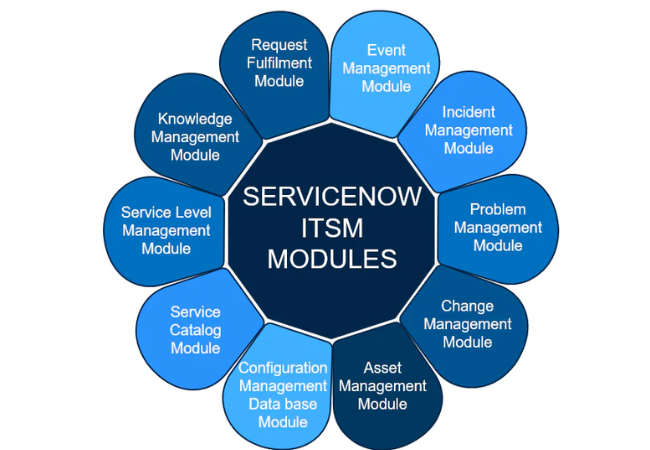ServiceNow Modules
ServiceNow offers a wide range of modules designed to streamline and automate various business processes. These modules are highly customizable and scalable to meet the specific needs of different industries. Below is a breakdown of some of the key ServiceNow modules:
1. IT Service Management (ITSM)
ITSM is one of the core modules of ServiceNow and is focused on delivering efficient IT services, helping organizations improve the management of incidents, problems, changes, and service requests.
- Incident Management: Helps quickly restore normal service operations after disruptions, minimizing the impact on business operations.
- Problem Management: Identifies and resolves the root causes of recurring incidents, reducing future disruptions.
- Change Management: Manages the lifecycle of all changes in the IT environment, ensuring minimal risk and downtime.
- Request Management: Handles user requests for services and products, providing a catalog of services available for end-users.
- Knowledge Management: Stores and shares knowledge and solutions, reducing the time spent on resolving issues.
- Service Catalog: A centralized platform where employees, customers, and other users can request IT and business services, products, or information in an easy-to-use, self-service environment.
2. IT Operations Management (ITOM)
ITOM focuses on managing and optimizing IT infrastructure, helping organizations automate, monitor, and manage their entire IT environment.
- Event Management: Monitors IT infrastructure to detect issues, providing real-time alerts and enabling proactive responses.
- Discovery: Automatically identifies devices, applications, and services in your network to build an accurate configuration management database (CMDB).
- Service Mapping: Maps the relationships between IT services and underlying infrastructure to ensure comprehensive monitoring and management.
- Cloud Management: Manages and optimizes cloud resources, helping businesses move to the cloud and maintain control over their environments.
3. IT Asset Management (ITAM)
ITAM helps organizations manage their IT assets throughout their lifecycle, from procurement to disposal.
- Asset Management: Tracks the physical and virtual assets, helping optimize usage and cost.
- Software Asset Management: Ensures compliance with software licenses and optimizes software procurement.
- Contract Management: Manages vendor contracts and agreements, providing a clear view of assets and associated costs.
4. IT Business Management (ITBM)
ITBM focuses on aligning IT projects and services with business objectives, enabling IT departments to deliver projects more efficiently.
- Project Portfolio Management (PPM): Manages the full lifecycle of IT projects, ensuring they meet business goals.
- Agile Development: Helps development teams manage and track their agile projects, improving collaboration and delivery timelines.
- Resource Management: Ensures optimal resource allocation for projects, improving the productivity and efficiency of teams.
5. Security Operations (SecOps)
SecOps focuses on integrating security with IT operations, enabling faster and more efficient responses to security incidents.
- Incident Response: Manages the lifecycle of security incidents, from detection to resolution.
- Vulnerability Response: Identifies and prioritizes vulnerabilities, ensuring organizations can quickly address critical threats.
- Security Incident Management: Helps teams manage and resolve security incidents efficiently, reducing potential damage.
6. Customer Service Management (CSM)
CSM improves customer experience by providing tools to efficiently manage customer inquiries, incidents, and service requests.
- Case Management: Manages customer cases, ensuring timely resolution and improving satisfaction.
- Knowledge Management: Empowers customers to resolve issues independently through self-service knowledge articles.
- Field Service Management: Manages field service operations, scheduling, and dispatching technicians for on-site services.
7. Human Resources Service Delivery (HRSD)
HRSD streamlines HR processes by automating workflows related to employee services.
- Case Management: Manages HR cases and provides employees with a self-service portal for accessing HR knowledge.
- Employee Service Center: A central hub for employees to access HR services, submit requests, and track progress.
- Onboarding and Transitions: Manages employee onboarding, offboarding, and internal transitions, ensuring smooth HR processes.
8. Governance, Risk, and Compliance (GRC)
GRC helps organizations manage risks, ensure compliance, and improve governance practices across business units.
- Risk Management:Identifies, assesses, and mitigates risks to minimize potential impacts on the organization.
- Audit Management: Manages audits across various departments, ensuring compliance with standards and regulations.
- Policy and Compliance Management: Ensures that the organization complies with industry standards and internal policies.
9. Virtual Agent
ServiceNow's Virtual Agent module provides AI-powered chatbots that automate customer service and IT support, delivering quick answers and resolving issues without human intervention.
- Conversational AI:Allows users to engage with virtual agents for troubleshooting and resolving requests via chat or voice.
- Bot Management Helps manage, optimize, and scale virtual agent implementations for enhanced user experience.
10. Performance Analytics
Performance Analytics provides real-time insights and dashboards to track and measure the performance of services, operations, and projects.
- Dashboards:Creates visual representations of key performance indicators (KPIs), helping businesses make informed decisions.
- Reporting:Generates customizable reports that give detailed insights into operations, performance, and service delivery.
- Forecasting: Uses data-driven models to predict future performance trends and outcomes.
11. Service Portal
The Service Portal is a user-friendly interface that allows users to interact with ServiceNow and access services, request information, or resolve issues easily.
- Self-Service Catalog: Provides a simple and intuitive interface for users to request IT services, track progress, and access knowledge articles.
- Personalized User Experience: Customizable portals that cater to the specific needs of different users and departments within the organization.
12. Application Portfolio Management (APM)
APM helps organizations manage their application portfolios by identifying redundancies, improving efficiency, and aligning applications with business objectives.
- Application Rationalization: Identifies underused applications and optimizes the application portfolio for better business outcomes.
- Cost Management: Helps track and manage the costs associated with running various applications across the organization.
13. Integration Hub
The Integration Hub is used for integrating third-party applications and services with ServiceNow, enabling seamless data exchange and automation across systems.
- Spokes:Pre-built connectors for popular third-party applications and services, streamlining integrations.
- Flow Designer: Provides a no-code interface for building custom integrations, automating workflows across platforms.

